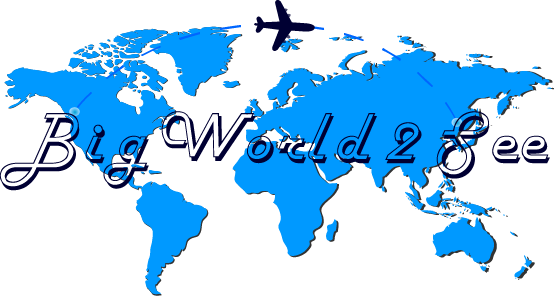Two weeks in Nepal… Nagarkot, Bhaktapur, and Chitwan… Rhinos but no Tigers We have now been in Nepal for two weeks. I am writing this post from our hotel in Pokhara. So far so good. We are having a great time. Nepali people are very friendly and helpful. And they are not pushy sales people. Last I wrote we had to make some changes to our plans. The Indian Visa process ended up taking us longer than we had expected. We submitted it on our first Monday in Kathmandu in the morning and then were able to pick it up the following Monday at 5pm. We had made plans to leave Kathmandu on the Saturday but had to extend it to Monday. So after a full week in Kathmandu we actually got to see some other places. Instead of staying in Kathmandu for the weekend we decided to go to Nagarkot which is about 42km outside of Kathmandu. Sounds close doesn’t it? That was about 2 hours on the bus. The vehicles drive through winding switchbacks. When a vehicle breaks down on the road they repair it right on the road… no tow trucks. They regularly pass on the curves and honk to alert oncoming vehicles that they are coming. It is not for the squeamish. Nicola and I both looked out the window at the same time as we passed slowly by a body covered with a white sheet and blood and a shoe on the road. I would not want to be a pedestrian on that road… or many roads in Nepal for that matter. 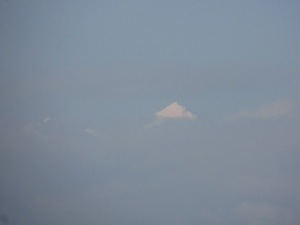 A sight of a mountain from the roof top of a nearby hotel in Nagarkot
A sight of a mountain from the roof top of a nearby hotel in Nagarkot  The hillside in Nagarkot
The hillside in Nagarkot  Sunset views from our roof top
Sunset views from our roof top 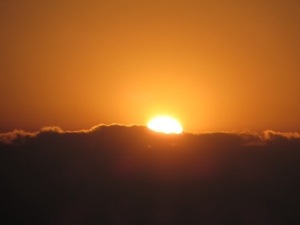 Another sunset view
Another sunset view  Nicola poses on the rooftop Nagarkot is known really for one thing only. Its hilltop views of sunset and sunrise over the Himalayas. On a clear day you might be able to get a glimpse of Everest although it will be very distant and small. Needless to say we did not get that view. It was very overcast and neither the sunrise or the sunset were spectacular. Nothing like we saw in the pictures. I guess we cannot always get lucky. We saw the sun set over the clouds which was pretty but not quite the view of the mountains we were hoping for. The next morning, I set my alarm to get up at 5:30am to watch the sunrise. We had a room that had a westerly facing view so we could just go out on our balcony for sunrise. No point though. It was foggy and cloudy and there was no sunrise. Too bad. We went for dinner in Nagarkot at another hotel. The power regularly goes out in this mountain town and the more upscale places have large generators. Ours did not but the End of the Universe Hotel did. We met a nice young couple, Tom and Tania, from England when we were seated with them. They had been to India before Nepal so had lots of suggestions on what to do and not do in India. Time flew by as we chatted with them and before we knew it, it was almost 10pm. We started walking back to our hotel but before long we arrived at a deserted locked gate to exit the End of the Universe. We scaled a wall to get out of the End of the Universe so I guess that we went beyond the end of the universe. Our hotel was only a few minutes away and when we arrived we found the gate to our place also locked and deserted. We called for help but no one came. We scaled another wall to get in. When I hit the ground I was met by a pack of three dogs. Luckily there was no growling or bearing of teeth. Imagine making your way through black streets, no lights around, and having to climb a wall and met by dogs on the other side. Could have been worse I guess. The next day we took the tourist bus to Bhaktapur. Bhaktapur is another UNESCO World Heritage site. Like Kathmandu and Patan, it also has a Durbar Square. We got a guide who led us around for two ours for 500 rupees (about $5). It was very helpful to understand what we were seeing. He told us more about Hindu religion and the meaning of the temples. We learned about several of the different gods that Hindu people worship. He also took us to a Thanka Painting School. Thanka painting is a type of Tibetan painting. The detail is phenomenal. Some of the areas are painted with a single hair brush. They do not use magnifying glasses and must have incredibly steady hands. I used a magnifying glass to look at the eyes on a face to see detail that amazed me. I did not buy one there but ended up buying a small one back in Kathmandu that I was told was done by a master. I will get it framed when back home.
Nicola poses on the rooftop Nagarkot is known really for one thing only. Its hilltop views of sunset and sunrise over the Himalayas. On a clear day you might be able to get a glimpse of Everest although it will be very distant and small. Needless to say we did not get that view. It was very overcast and neither the sunrise or the sunset were spectacular. Nothing like we saw in the pictures. I guess we cannot always get lucky. We saw the sun set over the clouds which was pretty but not quite the view of the mountains we were hoping for. The next morning, I set my alarm to get up at 5:30am to watch the sunrise. We had a room that had a westerly facing view so we could just go out on our balcony for sunrise. No point though. It was foggy and cloudy and there was no sunrise. Too bad. We went for dinner in Nagarkot at another hotel. The power regularly goes out in this mountain town and the more upscale places have large generators. Ours did not but the End of the Universe Hotel did. We met a nice young couple, Tom and Tania, from England when we were seated with them. They had been to India before Nepal so had lots of suggestions on what to do and not do in India. Time flew by as we chatted with them and before we knew it, it was almost 10pm. We started walking back to our hotel but before long we arrived at a deserted locked gate to exit the End of the Universe. We scaled a wall to get out of the End of the Universe so I guess that we went beyond the end of the universe. Our hotel was only a few minutes away and when we arrived we found the gate to our place also locked and deserted. We called for help but no one came. We scaled another wall to get in. When I hit the ground I was met by a pack of three dogs. Luckily there was no growling or bearing of teeth. Imagine making your way through black streets, no lights around, and having to climb a wall and met by dogs on the other side. Could have been worse I guess. The next day we took the tourist bus to Bhaktapur. Bhaktapur is another UNESCO World Heritage site. Like Kathmandu and Patan, it also has a Durbar Square. We got a guide who led us around for two ours for 500 rupees (about $5). It was very helpful to understand what we were seeing. He told us more about Hindu religion and the meaning of the temples. We learned about several of the different gods that Hindu people worship. He also took us to a Thanka Painting School. Thanka painting is a type of Tibetan painting. The detail is phenomenal. Some of the areas are painted with a single hair brush. They do not use magnifying glasses and must have incredibly steady hands. I used a magnifying glass to look at the eyes on a face to see detail that amazed me. I did not buy one there but ended up buying a small one back in Kathmandu that I was told was done by a master. I will get it framed when back home.  Lions with chains guard palace entrances
Lions with chains guard palace entrances  The Golden Gate
The Golden Gate  Nicola with a serpent fountain in the palace bath
Nicola with a serpent fountain in the palace bath  Statues of Hindu gods adorn doorways
Statues of Hindu gods adorn doorways 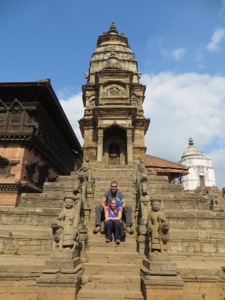 Statues of sacred animals protect temples
Statues of sacred animals protect temples  Nicola spots her first rhino
Nicola spots her first rhino 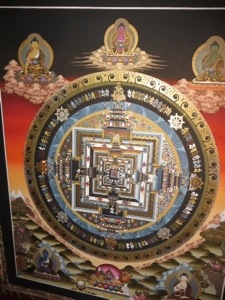 A Thanka painting called a Mandala
A Thanka painting called a Mandala  Hindu temple in Bhaktapur Durbar Square
Hindu temple in Bhaktapur Durbar Square  All but five animals are sacred to Hindus… They are the ones they will eat. Can you name them?
All but five animals are sacred to Hindus… They are the ones they will eat. Can you name them?  The walls are all bowed… Looks like they could fall at any minute
The walls are all bowed… Looks like they could fall at any minute  The traditional way of spinning pottery
The traditional way of spinning pottery  A scene from the movie Ghost After spending about three hours in Bhaktapur and having lunch in the main square, we took a taxi back to Kathmandu. It took about 45 minutes and cost 650 rupees (about $6.50). We were heading back to our hotel when we were called in by a guy who we had told we would come back later to look at his rugs. Nicola has been wanting to buy a small carpet for her side of the bed at home. We looked in Morocco and Turkey but the prices were quite outrageous. I think we were just putting this guy off when we told him we would come back. Nevertheless we had a look. Nicola actually found a silk rug that she liked and ended up buying. The price was not outrageous either… or maybe it is just that we were done looking and this seemed like a nice one. The next day we had lots of time to kill before 5pm when we would pick up our Indian visas. We decided to go to Pashuputinath. We had walked there earlier in the week but did not go in because it was expensive and we did not know exactly what it was. We later learned that it was a Hindu cremation site on a river which is a tributary of the Ganges in India. I decided that it was something that I wanted to see. We took a taxi. We tried to take a bicycle guy but he wanted way too much because it was very uphill. Here also we ended up getting a guide. This time for 1000 rupees but I think it was a $10 well spent. I do not think either of us expected to see what we did. He led us immediately to an area right above the cremation location. 10 concrete platforms jut out into the river. On the platforms logs are stacked to form another platform on which the body will be burned. Almost as soon as we got to this location, three bodies were brought out and placed on three different platforms. The sons of the deceased carry the body out and ritually circle the body on the platform several times. Depending on how much the family has paid for the service, the different platforms are decorated with flowers and other adornments. One of the people that was being cremated must have been in the military because on the far side of the river the military stood at attention, saluted, and played the trumpet much like one would hear at the funeral of a Canadian or America soldier. Finally, the eldest son approaches the body, uncovers the face, and ignites something placed in the mouth of their parent. The man working at the cremation then covers the face and then proceeds to cover the rest of the body with wood and hay. The whole process takes about 3-4 hours and the ashes are then pushed into the river. At this place they cremate about 40 bodies per day and it happens 24 hours per day. Once the bodies were set on fire and the ceremony was done, we toured around the rest of Pashuputinath. There are many monkeys running free here as they believe that monkeys are holy. There are Hindu holy men who live very meagrely in very small temples… I think they call them them Sadhus. Different Sadhus worship different gods and that is why they look different and worship differently. We also saw a body being washed and prepared for cremation by the family. They do not wash them in the river any more because it is so polluted. We felt like weird watching this whole process much like if you were to watch a funeral as a spectator. It also felt strange that we were allowed to take pictures. I guess for Hindu people they believe that this is not the end but rather the beginning of the next life.
A scene from the movie Ghost After spending about three hours in Bhaktapur and having lunch in the main square, we took a taxi back to Kathmandu. It took about 45 minutes and cost 650 rupees (about $6.50). We were heading back to our hotel when we were called in by a guy who we had told we would come back later to look at his rugs. Nicola has been wanting to buy a small carpet for her side of the bed at home. We looked in Morocco and Turkey but the prices were quite outrageous. I think we were just putting this guy off when we told him we would come back. Nevertheless we had a look. Nicola actually found a silk rug that she liked and ended up buying. The price was not outrageous either… or maybe it is just that we were done looking and this seemed like a nice one. The next day we had lots of time to kill before 5pm when we would pick up our Indian visas. We decided to go to Pashuputinath. We had walked there earlier in the week but did not go in because it was expensive and we did not know exactly what it was. We later learned that it was a Hindu cremation site on a river which is a tributary of the Ganges in India. I decided that it was something that I wanted to see. We took a taxi. We tried to take a bicycle guy but he wanted way too much because it was very uphill. Here also we ended up getting a guide. This time for 1000 rupees but I think it was a $10 well spent. I do not think either of us expected to see what we did. He led us immediately to an area right above the cremation location. 10 concrete platforms jut out into the river. On the platforms logs are stacked to form another platform on which the body will be burned. Almost as soon as we got to this location, three bodies were brought out and placed on three different platforms. The sons of the deceased carry the body out and ritually circle the body on the platform several times. Depending on how much the family has paid for the service, the different platforms are decorated with flowers and other adornments. One of the people that was being cremated must have been in the military because on the far side of the river the military stood at attention, saluted, and played the trumpet much like one would hear at the funeral of a Canadian or America soldier. Finally, the eldest son approaches the body, uncovers the face, and ignites something placed in the mouth of their parent. The man working at the cremation then covers the face and then proceeds to cover the rest of the body with wood and hay. The whole process takes about 3-4 hours and the ashes are then pushed into the river. At this place they cremate about 40 bodies per day and it happens 24 hours per day. Once the bodies were set on fire and the ceremony was done, we toured around the rest of Pashuputinath. There are many monkeys running free here as they believe that monkeys are holy. There are Hindu holy men who live very meagrely in very small temples… I think they call them them Sadhus. Different Sadhus worship different gods and that is why they look different and worship differently. We also saw a body being washed and prepared for cremation by the family. They do not wash them in the river any more because it is so polluted. We felt like weird watching this whole process much like if you were to watch a funeral as a spectator. It also felt strange that we were allowed to take pictures. I guess for Hindu people they believe that this is not the end but rather the beginning of the next life.  A body is brought to the platform by sons of the deceased
A body is brought to the platform by sons of the deceased  A body is washed and prepared
A body is washed and prepared  3 bodies are cremated across the river
3 bodies are cremated across the river  Some Sadhus live in Pashuputinath
Some Sadhus live in Pashuputinath 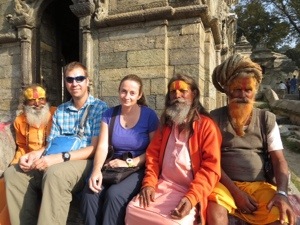 They tried to get us to give them $20 for the photo
They tried to get us to give them $20 for the photo  This Sadhu is naked
This Sadhu is naked  Phallic symbols are used regularly in Hindu architecture as a symbol of life
Phallic symbols are used regularly in Hindu architecture as a symbol of life  The quintessential temple monkey picture
The quintessential temple monkey picture  Monkeys are holy and protected We got dropped off right in the heart of Thamel. We wanted to look for some long johns for Nicola for her trekking and a couple of other things. Thamel is an amazing area for getting cheap Chinese knockoff North Face, Columbia, Mammut, Patagonia. You name it you can get it there. It was in Thamel that I bought my Thanka painting. Nicola got a hole in her pants when she was in London when she tried to remove some was from her pants but ended up with a hole. She wanted to see about having something embroidered over the hole instead of putting a patch. Artisans work in shop fronts and embroider whatever you want freehand. She decided to get the flag of Nepal embroidered over the hole. I decided to get a small Buddha face (like that on the Buddhist temple stupas) embroidered on the back of my fleece and the Hindu god Ganesha (revered as the remover of obstacles, the patron of arts and science, and the deva of wisdom and intellect… and is a sign of good luck) on the front. Each embroidery was 450 rupees. Nicola also got a Buddha face on her fleece. She also bought a yak wool scarf to keep her warm.
Monkeys are holy and protected We got dropped off right in the heart of Thamel. We wanted to look for some long johns for Nicola for her trekking and a couple of other things. Thamel is an amazing area for getting cheap Chinese knockoff North Face, Columbia, Mammut, Patagonia. You name it you can get it there. It was in Thamel that I bought my Thanka painting. Nicola got a hole in her pants when she was in London when she tried to remove some was from her pants but ended up with a hole. She wanted to see about having something embroidered over the hole instead of putting a patch. Artisans work in shop fronts and embroider whatever you want freehand. She decided to get the flag of Nepal embroidered over the hole. I decided to get a small Buddha face (like that on the Buddhist temple stupas) embroidered on the back of my fleece and the Hindu god Ganesha (revered as the remover of obstacles, the patron of arts and science, and the deva of wisdom and intellect… and is a sign of good luck) on the front. Each embroidery was 450 rupees. Nicola also got a Buddha face on her fleece. She also bought a yak wool scarf to keep her warm.  He embroiders the Buddha face with no guide. He used a pattern for my Gonesha I happy to say that we got our Indian Visas finally on the Monday, a week after we began the process. It is for two months but by the time we get there we may have six weeks left on it. We would leave the next day for Chitwan National Park. We took a 6 hour bus ride to Chitwan which is around 220km from Kathmandu. I sat at the back and bounced all the way to Chitwan. A Chinese man sitting in front of me actually smashed his face on the seat in front of him on one bump and he got a bloody nose. We were going to Chitwan to see rhinos and hopefully a tiger. For 4 days and 3 nights including all activities and meals the cost was $270 for the two of us. We stayed at the Unique Wild Resort but I believe that there are 25 companies that provide this kind of service. Our guide met us at the bus. After lunch he took us and a young Chinese couple for a nature walk and to see sunset. We soon saw many elephants although they were all captive elephants which are used for tourism and park management. We also saw a crocodile (actually a gharial) while we watched the sunset. After dinner we went to a Tharu cultural dance show. Tharu are the indigenous people of the Chitwan area. The Tharu stick dance was quite impressive. Young men go in a circle and spin sticks around and hit them against each other’s sticks in what seems like a dangerous yet well choreographed show. I wonder if they wear helmets when they learn this dance.
He embroiders the Buddha face with no guide. He used a pattern for my Gonesha I happy to say that we got our Indian Visas finally on the Monday, a week after we began the process. It is for two months but by the time we get there we may have six weeks left on it. We would leave the next day for Chitwan National Park. We took a 6 hour bus ride to Chitwan which is around 220km from Kathmandu. I sat at the back and bounced all the way to Chitwan. A Chinese man sitting in front of me actually smashed his face on the seat in front of him on one bump and he got a bloody nose. We were going to Chitwan to see rhinos and hopefully a tiger. For 4 days and 3 nights including all activities and meals the cost was $270 for the two of us. We stayed at the Unique Wild Resort but I believe that there are 25 companies that provide this kind of service. Our guide met us at the bus. After lunch he took us and a young Chinese couple for a nature walk and to see sunset. We soon saw many elephants although they were all captive elephants which are used for tourism and park management. We also saw a crocodile (actually a gharial) while we watched the sunset. After dinner we went to a Tharu cultural dance show. Tharu are the indigenous people of the Chitwan area. The Tharu stick dance was quite impressive. Young men go in a circle and spin sticks around and hit them against each other’s sticks in what seems like a dangerous yet well choreographed show. I wonder if they wear helmets when they learn this dance.  Goats for milk and meat
Goats for milk and meat  Baby goats
Baby goats  Baby elephants. Momma doesn’t have to work for 4 years after having a baby… Quite the maternity leave
Baby elephants. Momma doesn’t have to work for 4 years after having a baby… Quite the maternity leave  He is making elephant candy. They love it and even when allowed to roam free come back for the candy
He is making elephant candy. They love it and even when allowed to roam free come back for the candy  This is called a touch me not. It shrivels when you touch it
This is called a touch me not. It shrivels when you touch it  Rhino poop. Rhinos poop in the same spot to mark territory
Rhino poop. Rhinos poop in the same spot to mark territory  On the riverbank waiting for sunset
On the riverbank waiting for sunset  Riverbank sunset
Riverbank sunset  Tharu stick dance… a little out of focus because it was dark and they were moving fast
Tharu stick dance… a little out of focus because it was dark and they were moving fast  She was the MC and a dancer
She was the MC and a dancer  The peacock dance
The peacock dance  Nicola got up and danced On day two in Chitwan we were up early for a morning boat ride in a dugout canoe. The ride was only about 30 or 40 minutes. It was an opportunity to see more crocs, lots of birds, but no wild elephants or rhinos near the water. We ended on the other side of the river in the park. We got out and did a nature walk. We saw deer and peacocks… no tigers or rhinos though. After the nature walk, we ended back at the river and crossed a rickety bridge back to the other side. We took the jeep to where the elephants are bathed each morning at 11am. Nicola and I paid the 100 rupees each to be on the elephant as he is bathed. He continually is prodded to spray water at us with his trunk. A blend of river water and elephant snot. It was quite fun and was definitely memorable.
Nicola got up and danced On day two in Chitwan we were up early for a morning boat ride in a dugout canoe. The ride was only about 30 or 40 minutes. It was an opportunity to see more crocs, lots of birds, but no wild elephants or rhinos near the water. We ended on the other side of the river in the park. We got out and did a nature walk. We saw deer and peacocks… no tigers or rhinos though. After the nature walk, we ended back at the river and crossed a rickety bridge back to the other side. We took the jeep to where the elephants are bathed each morning at 11am. Nicola and I paid the 100 rupees each to be on the elephant as he is bathed. He continually is prodded to spray water at us with his trunk. A blend of river water and elephant snot. It was quite fun and was definitely memorable.  Breakfast included Tibetan bread which was like Dough Guts from back home
Breakfast included Tibetan bread which was like Dough Guts from back home  Misty morning boat ride
Misty morning boat ride 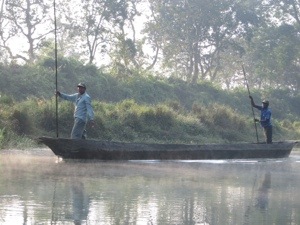 Passers by… in the fast lane
Passers by… in the fast lane  A nearby boat in the mist
A nearby boat in the mist  A croc hides below the water surface
A croc hides below the water surface  I forget what kind of bird this guy is
I forget what kind of bird this guy is  Elephant poop floats in the river
Elephant poop floats in the river  This bull is popular with the egrets
This bull is popular with the egrets  Spotted dear
Spotted dear  Tree climbing
Tree climbing  Not sure if these are roots growing up or something growing down around the tree
Not sure if these are roots growing up or something growing down around the tree  Nicola compares her foot size to an elephant foot print
Nicola compares her foot size to an elephant foot print  Up close and personal with a baby. You can see Nic’s Nepal flag embroidered on her pants in this pic
Up close and personal with a baby. You can see Nic’s Nepal flag embroidered on her pants in this pic  Baby makes an escape attempt
Baby makes an escape attempt  And he got out
And he got out  You can tell and Indian elephant because their ear is shaped like India while an African elephant ear is shaped like Africa… cool eh?
You can tell and Indian elephant because their ear is shaped like India while an African elephant ear is shaped like Africa… cool eh?  Elephant bathing
Elephant bathing  First soaker
First soaker  We got to switch front and back
We got to switch front and back  I almost did not make it up After lunch, we did a jeep safari. This was a good chance to see wildlife. The jeep can go very deep into the jungle in the five hour tour. However, the noise of the jeep does a good job of keeping the wildlife in the jungle I am sure. Also, at this time of year the grass is so high that it is almost impossible to see anything. It is like looking at a wall of overgrown grass on either side of the jeep at some points. Nevertheless, we saw some deer and some very large birds in the distance. In the final moments of our ride, we spotted a rhino crouched down in the ditch on the side of the road. Our jeep stopped. The rhino came right out into the road and faced us. He was maybe 20 metres away. When he took a step towards us, our driver started the engine and the rhino bolted into the grasses on the other side of the road. Rhinos are the most dangerous animal in Chitwan. Last month a guide was killed by a rhino in Chitwan when he was leading tourists on a jungle walk. They get particularly aggressive when it is a mother with a baby.
I almost did not make it up After lunch, we did a jeep safari. This was a good chance to see wildlife. The jeep can go very deep into the jungle in the five hour tour. However, the noise of the jeep does a good job of keeping the wildlife in the jungle I am sure. Also, at this time of year the grass is so high that it is almost impossible to see anything. It is like looking at a wall of overgrown grass on either side of the jeep at some points. Nevertheless, we saw some deer and some very large birds in the distance. In the final moments of our ride, we spotted a rhino crouched down in the ditch on the side of the road. Our jeep stopped. The rhino came right out into the road and faced us. He was maybe 20 metres away. When he took a step towards us, our driver started the engine and the rhino bolted into the grasses on the other side of the road. Rhinos are the most dangerous animal in Chitwan. Last month a guide was killed by a rhino in Chitwan when he was leading tourists on a jungle walk. They get particularly aggressive when it is a mother with a baby.  Big bird nest… again do not recall the type
Big bird nest… again do not recall the type  Lizard camouflaged on tree
Lizard camouflaged on tree 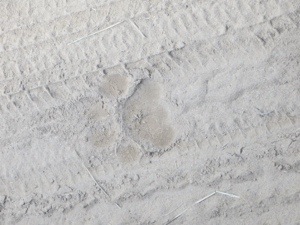 Tiger tracks
Tiger tracks  A gharial is a fish eater only. A member of the croc family
A gharial is a fish eater only. A member of the croc family  He gets an unfortunate growth on his nose as he gets older
He gets an unfortunate growth on his nose as he gets older 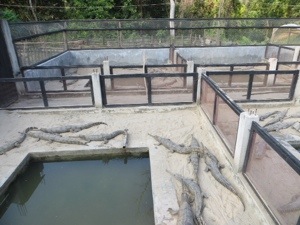 We visited a gharial breeding centre. Some will stay here for many years. Oldest were Nicola’s age.
We visited a gharial breeding centre. Some will stay here for many years. Oldest were Nicola’s age.  This croc is a max mugger. He will eat you
This croc is a max mugger. He will eat you  Rhino crouches in ditch
Rhino crouches in ditch  He came out to check us out Day three we were up very early for a bird watching walk. I am not a big bird fan but enjoyed the nature walk. We did not see many birds but our guide took us by elephant stables on the way back and the baby was particularly adorable. That afternoon we went on an elephant ride safari. This was our next big chance to see a tiger. The elephants are better for seeing wildlife because you are higher up and the animals are not scared away by the elephants. We got quite close to a croc as we crossed the river. The ride is not very comfortable really. It is very bouncy and your body seems to be flailing around a lot. We got to an open pasture where there was a mother and baby rhino grazing. When there is one elephant and one rhino the rhino is likely to be aggressive. When there is several elephants, and there were, the rhino just keeps its head down because it knows it is outnumbered. We were so close to the rhinos… it was amazing. They are so unique and their skin is so strange.
He came out to check us out Day three we were up very early for a bird watching walk. I am not a big bird fan but enjoyed the nature walk. We did not see many birds but our guide took us by elephant stables on the way back and the baby was particularly adorable. That afternoon we went on an elephant ride safari. This was our next big chance to see a tiger. The elephants are better for seeing wildlife because you are higher up and the animals are not scared away by the elephants. We got quite close to a croc as we crossed the river. The ride is not very comfortable really. It is very bouncy and your body seems to be flailing around a lot. We got to an open pasture where there was a mother and baby rhino grazing. When there is one elephant and one rhino the rhino is likely to be aggressive. When there is several elephants, and there were, the rhino just keeps its head down because it knows it is outnumbered. We were so close to the rhinos… it was amazing. They are so unique and their skin is so strange.  Some bug
Some bug  Elephants in the mist
Elephants in the mist 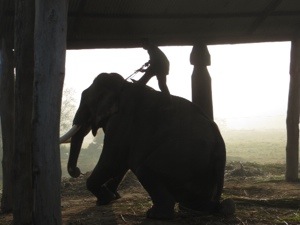 Each government elephant has three trainers and keepers
Each government elephant has three trainers and keepers  A water buffalo
A water buffalo  Some elephants work until they are 60… drivers too
Some elephants work until they are 60… drivers too  Deer are not spooked by the elephants
Deer are not spooked by the elephants  Elephant ri
Elephant ri
